This article is about the Sun and its planetary system. For other systems, see planetary system and star system. For a list of physical and orbital statistics for the Solar System's largest bodies, see List of gravitationally rounded objects of the Solar System
| Objects in the Solar System |
|---|
| Categories |
The Solar System[a] consists of the Sun and the astronomical objects gravitationally bound in orbit around it, all of which formed from the collapse of a giant molecular cloud approximately 4.6 billion years ago. The vast majority of the system's mass (well over 99%) is in the Sun. Of the many objects that orbit the Sun, most of themass is contained within eight relatively solitary planets[e] whose orbits are almost circular and lie within a nearly flat disc called the ecliptic plane. The four smaller inner planets, Mercury, Venus, Earth and Mars, also called the terrestrial planets, are primarily composed of rock and metal. The four outer planets, the gas giants, are substantially more massive than the terrestrials. The two largest, Jupiter and Saturn, are composed mainly of hydrogen and helium; the two outermost planets, Uranus and Neptune, are composed largely of ices, such as water, ammonia and methane, and are often referred to separately as "ice giants".
The Solar System is also home to a number of regions populated by smaller objects. The asteroid belt, which lies between Mars and Jupiter, is similar to the terrestrial planets as it is composed mainly of rock and metal. Beyond Neptune's orbit lie the Kuiper belt and scattered disc; linked populations of trans-Neptunian objectscomposed mostly of ices such as water, ammonia and methane. Within these populations, five individual objects, Ceres, Pluto, Haumea, Makemake and Eris, are recognized to be large enough to have been rounded by their own gravity, and are thus termed dwarf planets.[e] In addition to thousands of small bodies[e] in those two regions, various other small body populations, such as comets, centaurs and interplanetary dust, freely travel between regions.
Six of the planets and three of the dwarf planets are orbited by natural satellites,[b] usually termed "moons" after Earth's Moon. Each of the outer planets is encircled by planetary rings of dust and other particles.
The solar wind, a flow of plasma from the Sun, creates a bubble in the interstellar medium known as the heliosphere, which extends out to the edge of the scattered disc. The hypothetical Oort cloud, which acts as the source for long-period comets, may also exist at a distance roughly a thousand times further than the heliosphere.
The Solar System is located in the Milky Way galaxy, which contains about 200 billion stars.
Contents[hide] |
Discovery and exploration
For many thousands of years, humanity, with a few notable exceptions, did not recognize the existence of the Solar System. People believed the Earth to be stationary at the centre of the universe and categorically different from the divine or ethereal objects that moved through the sky. Although the Greek philosopher Aristarchus of Samos had speculated on a heliocentric reordering of the cosmos,[1] Nicolaus Copernicus was the first to develop a mathematically predictive heliocentric system.[2] His 17th-century successors, Galileo Galilei,Johannes Kepler and Isaac Newton, developed an understanding of physics that led to the gradual acceptance of the idea that the Earth moves around the Sun and that the planets are governed by the same physical laws that governed the Earth. Additionally, the invention of the telescope led to the discovery of further planets and moons. In more recent times, improvements in the telescope and the use of unmanned spacecraft have enabled the investigation of geological phenomena such as mountains and craters, and seasonal meteorological phenomena such as clouds, dust storms and ice caps on the other planets.
Structure
The principal component of the Solar System is the Sun, a main-sequence G2 star that contains 99.86 percent of the system's known mass and dominates it gravitationally.[3] The Sun's four largest orbiting bodies, the gas giants, account for 99 percent of the remaining mass, with Jupiter and Saturn together comprising more than 90 percent.[c]
Most large objects in orbit around the Sun lie near the plane of Earth's orbit, known as the ecliptic. The planets are very close to the ecliptic while comets and Kuiper belt objects are frequently at significantly greater angles to it.[4][5] All the planets and most other objects orbit the Sun in the same direction that the Sun is rotating (counter-clockwise, as viewed from above the Sun's north pole).[6] There are exceptions, such as Halley's Comet.
The overall structure of the charted regions of the Solar System consists of the Sun, four relatively small inner planets surrounded by a belt of rocky asteroids, and four gas giants surrounded by the outer Kuiper belt of icy objects. Astronomers sometimes informally divide this structure into separate regions. The inner Solar Systemincludes the four terrestrial planets and the asteroid belt. The outer Solar System is beyond the asteroids, including the four gas giant planets.[7] Since the discovery of the Kuiper belt, the outermost parts of the Solar System are considered a distinct region consisting of the objects beyond Neptune.[8]
Kepler's laws of planetary motion describe the orbits of objects about the Sun. Following Kepler's laws, each object travels along an ellipse with the Sun at one focus. Objects closer to the Sun (with smaller semi-major axes) travel more quickly, as they are more affected by the Sun's gravity. On an elliptical orbit, a body's distance from the Sun varies over the course of its year. A body's closest approach to the Sun is called itsperihelion, while its most distant point from the Sun is called its aphelion. The orbits of the planets are nearly circular, but many comets, asteroids and Kuiper belt objects follow highly elliptical orbits.
Due to the vast distances involved, many representations of the Solar System show orbits the same distance apart. In reality, with a few exceptions, the farther a planet or belt is from the Sun, the larger the distance between it and the previous orbit. For example, Venus is approximately 0.33 astronomical units (AU)[d] farther out from the Sun than Mercury, while Saturn is 4.3 AU out from Jupiter, and Neptune lies 10.5 AU out from Uranus. Attempts have been made to determine a relationship between these orbital distances (for example, the Titius–Bode law),[9] but no such theory has been accepted.
Most of the planets in the Solar System possess secondary systems of their own, being orbited by planetary objects called natural satellites, or moons (two of which are larger than the planet Mercury), or, in the case of the four gas giants, by planetary rings; thin bands of tiny particles that orbit them in unison. Most of the largest natural satellites are in synchronous rotation, with one face permanently turned toward their parent.

Range of selected bodies of the Solar System from the middle of the Sun. The left and right edges of each bar correspond to the perihelion and aphelion of the body, respectively. Long bars denote high orbital eccentricity.
Composition
The Sun, which comprises nearly all the matter in the Solar System, is composed of roughly 98% hydrogen and helium.[10] Jupiter and Saturn, which comprise nearly all the remaining matter, possess atmospheres composed of roughly 99% of those same elements.[11][12] A composition gradient exists in the Solar System, created by heat and light pressure from the Sun; those objects closer to the Sun, which are more affected by heat and light pressure, are composed of elements with high melting points. Objects farther from the Sun are composed largely of materials with lower melting points.[13] The boundary in the Solar System beyond which those volatile substances could condense is known as the frost line, and it lies at roughly 4 AU from the Sun.[14]
The objects of the inner Solar System are composed mostly of rock,[15] the collective name for compounds with high melting points, such as silicates, iron or nickel, that remained solid under almost all conditions in the protoplanetary nebula.[16] Jupiter and Saturn are composed mainly of gases, the astronomical term for materials with extremely low melting points and high vapor pressure such as molecular hydrogen, helium, and neon, which were always in the gaseous phase in the nebula.[16] Ices, like water, methane, ammonia, hydrogen sulfide andcarbon dioxide,[15] have melting points up to a few hundred kelvins, while their phase depends on the ambient pressure and temperature.[16] They can be found as ices, liquids, or gases in various places in the Solar System, while in the nebula they were either in the solid or gaseous phase.[16] Icy substances comprise the majority of the satellites of the giant planets, as well as most of Uranus and Neptune (the so-called "ice giants") and the numerous small objects that lie beyond Neptune's orbit.[15][17] Together, gases and ices are referred to asvolatiles.[18]
Sun
The Sun is the Solar System's star, and by far its chief component. Its large mass (332,900 Earth masses)[19] produces temperatures and densities in its core great enough to sustain nuclear fusion,[20] which releases enormous amounts of energy, mostly radiated into space as electromagnetic radiation, peaking in the 400–700 nm band we call visible light.[21]
The Sun is classified as a type G2 yellow dwarf, but this name is misleading as, compared to the majority of stars in our galaxy, the Sun is rather large and bright.[22] Stars are classified by the Hertzsprung–Russell diagram, a graph that plots the brightness of stars with their surface temperatures. Generally, hotter stars are brighter. Stars following this pattern are said to be on the main sequence, and the Sun lies right in the middle of it. However, stars brighter and hotter than the Sun are rare, while substantially dimmer and cooler stars, known as red dwarfs, are common, making up 85 percent of the stars in the galaxy.[22][23]
Evidence suggests that the Sun's position on the main sequence puts it in the "prime of life" for a star, in that it has not yet exhausted its store of hydrogen for nuclear fusion. The Sun is growing brighter; early in its history it was 70 percent as bright as it is today.[24]
The Sun is a population I star; it was born in the later stages of the universe's evolution, and thus contains more elements heavier than hydrogen and helium ("metals" in astronomical parlance) than older population II stars.[25] Elements heavier than hydrogen and helium were formed in the cores of ancient and exploding stars, so the first generation of stars had to die before the universe could be enriched with these atoms. The oldest stars contain few metals, while stars born later have more. This high metallicity is thought to have been crucial to the Sun's developing a planetary system, because planets form from accretion of "metals".[26]
Interplanetary medium
Along with light, the Sun radiates a continuous stream of charged particles (a plasma) known as the solar wind. This stream of particles spreads outwards at roughly 1.5 million kilometres per hour,[27] creating a tenuous atmosphere (the heliosphere) that permeates the Solar System out to at least 100 AU (see heliopause).[28] This is known as the interplanetary medium. Activity on the Sun's surface, such as solar flares and coronal mass ejections, disturb the heliosphere, creating space weather and causing geomagnetic storms.[29] The largest structure within the heliosphere is the heliospheric current sheet, a spiral form created by the actions of the Sun's rotating magnetic field on the interplanetary medium.[30][31]
Earth's magnetic field stops its atmosphere from being stripped away by the solar wind. Venus and Mars do not have magnetic fields, and as a result, the solar wind causes their atmospheres to gradually bleed away into space.[32] Coronal mass ejections and similar events blow a magnetic field and huge quantities of material from the surface of the Sun. The interaction of this magnetic field and material with Earth's magnetic field funnels charged particles into the Earth's upper atmosphere, where its interactions create aurorae seen near the magnetic poles.
Cosmic rays originate outside the Solar System. The heliosphere partially shields the Solar System, and planetary magnetic fields (for those planets that have them) also provide some protection. The density of cosmic rays in the interstellar medium and the strength of the Sun's magnetic field change on very long timescales, so the level of cosmic radiation in the Solar System varies, though by how much is unknown.[33]
The interplanetary medium is home to at least two disc-like regions of cosmic dust. The first, the zodiacal dust cloud, lies in the inner Solar System and causes zodiacal light. It was likely formed by collisions within the asteroid belt brought on by interactions with the planets.[34] The second extends from about 10 AU to about 40 AU, and was probably created by similar collisions within the Kuiper belt.[35][36]
Inner Solar System
The inner Solar System is the traditional name for the region comprising the terrestrial planets and asteroids.[37] Composed mainly of silicates and metals, the objects of the inner Solar System are relatively close to the Sun; the radius of this entire region is shorter than the distance between Jupiter and Saturn.
Inner planets
The four inner or terrestrial planets have dense, rocky compositions, few or no moons, and no ring systems. They are composed largely ofrefractory minerals, such as the silicates, which form their crusts and mantles, and metals such as iron and nickel, which form their cores. Three of the four inner planets (Venus, Earth and Mars) have atmospheres substantial enough to generate weather; all have impact craters andtectonic surface features such as rift valleys and volcanoes. The term inner planet should not be confused with inferior planet, which designates those planets that are closer to the Sun than Earth is (i.e. Mercury and Venus).
Mercury
- Mercury (0.4 AU from the Sun) is the closest planet to the Sun and the smallest planet in the Solar System (0.055 Earth masses). Mercury has no natural satellites, and its only known geological features besides impact craters are lobed ridges or rupes, probably produced by a period of contraction early in its history.[38] Mercury's almost negligible atmosphere consists of atoms blasted off its surface by the solar wind.[39] Its relatively large iron core and thin mantle have not yet been adequately explained. Hypotheses include that its outer layers were stripped off by a giant impact, and that it was prevented from fully accreting by the young Sun's energy.[40][41]
Venus
- Venus (0.7 AU from the Sun) is close in size to Earth (0.815 Earth masses), and, like Earth, has a thick silicate mantle around an iron core, a substantial atmosphere and evidence of internal geological activity. However, it is much drier than Earth and its atmosphere is ninety times as dense. Venus has no natural satellites. It is the hottest planet, with surface temperatures over 400 °C, most likely due to the amount of greenhouse gases in the atmosphere.[42] No definitive evidence of current geological activity has been detected on Venus, but it has no magnetic field that would prevent depletion of its substantial atmosphere, which suggests that its atmosphere is regularly replenished by volcanic eruptions.[43]
Earth
- Earth (1 AU from the Sun) is the largest and densest of the inner planets, the only one known to have current geological activity, and is the only place in the Solar System where lifeis known to exist.[44] Its liquid hydrosphere is unique among the terrestrial planets, and it is also the only planet where plate tectonics has been observed. Earth's atmosphere is radically different from those of the other planets, having been altered by the presence of life to contain 21% free oxygen.[45] It has one natural satellite, the Moon, the only large satellite of a terrestrial planet in the Solar System.
Mars
- Mars (1.5 AU from the Sun) is smaller than Earth and Venus (0.107 Earth masses). It possesses an atmosphere of mostly carbon dioxide with a surface pressure of 6.1 millibars (roughly 0.6 percent that of the Earth's).[46] Its surface, peppered with vast volcanoes such as Olympus Mons and rift valleys such as Valles Marineris, shows geological activity that may have persisted until as recently as 2 million years ago.[47] Its red colour comes from iron oxide (rust) in its soil.[48] Mars has two tiny natural satellites (Deimos and Phobos) thought to be captured asteroids.[49]
Asteroid belt
Asteroids are small Solar System bodies[e] composed mainly of refractory rocky and metallic minerals, with some ice.[50]
The asteroid belt occupies the orbit between Mars and Jupiter, between 2.3 and 3.3 AU from the Sun. It is thought to be remnants from the Solar System's formation that failed to coalesce because of the gravitational interference of Jupiter.[51]
Asteroids range in size from hundreds of kilometres across to microscopic. All asteroids except the largest, Ceres, are classified as small Solar System bodies, but some asteroids such as Vesta and Hygiea may be reclassed as dwarf planets if they are shown to have achieved hydrostatic equilibrium.[52]
The asteroid belt contains tens of thousands, possibly millions, of objects over one kilometre in diameter.[53] Despite this, the total mass of the asteroid belt is unlikely to be more than a thousandth of that of the Earth.[54] The asteroid belt is very sparsely populated; spacecraft routinely pass through without incident. Asteroids with diameters between 10 and 10−4 m are calledmeteoroids.[55]
Ceres
Ceres (2.77 AU) is the largest asteroid, a protoplanet, and a dwarf planet.[e] It has a diameter of slightly under 1000 km, and a mass large enough for its own gravity to pull it into a spherical shape. Ceres was considered a planet when it was discovered in the 19th century, but was reclassified as an asteroid in the 1850s as further observations revealed additional asteroids.[56] It was classified in 2006 as a dwarf planet.
Asteroid groups
Asteroids in the asteroid belt are divided into asteroid groups and families based on their orbital characteristics. Asteroid moons are asteroids that orbit larger asteroids. They are not as clearly distinguished as planetary moons, sometimes being almost as large as their partners. The asteroid belt also contains main-belt comets, which may have been the source of Earth's water.[57]
Trojan asteroids are located in either of Jupiter's L4 or L5 points (gravitationally stable regions leading and trailing a planet in its orbit); the term "Trojan" is also used for small bodies in any other planetary or satellite Lagrange point. Hilda asteroids are in a 2:3 resonance with Jupiter; that is, they go around the Sun three times for every two Jupiter orbits.[58]
The inner Solar System is also dusted with rogue asteroids, many of which cross the orbits of the inner planets.[59]
Outer Solar System
The outer region of the Solar System is home to the gas giants and their large moons. Many short-period comets, including the centaurs, also orbit in this region. Due to their greater distance from the Sun, the solid objects in the outer Solar System contain a higher proportion of volatiles such as water, ammonia and methane, than the rocky denizens of the inner Solar System, as the colder temperatures allow these compounds to remain solid.
Outer planets
The four outer planets, or gas giants (sometimes called Jovian planets), collectively make up 99 percent of the mass known to orbit the Sun.[c]Jupiter and Saturn are each many tens of times the mass of the Earth and consist overwhelmingly of hydrogen and helium; Uranus and Neptune are far less massive (<20 Earth masses) and possess more ices in their makeup. For these reasons, some astronomers suggest they belong in their own category, “ice giants.”[60] All four gas giants have rings, although only Saturn's ring system is easily observed from Earth. The term outer planet should not be confused with superior planet, which designates planets outside Earth's orbit and thus includes both the outer planets and Mars.
Jupiter
- Jupiter (5.2 AU), at 318 Earth masses, is 2.5 times the mass of all the other planets put together. It is composed largely of hydrogen andhelium. Jupiter's strong internal heat creates a number of semi-permanent features in its atmosphere, such as cloud bands and the Great Red Spot.
- Jupiter has 64 known satellites. The four largest, Ganymede, Callisto, Io, and Europa, show similarities to the terrestrial planets, such as volcanism and internal heating.[61] Ganymede, the largest satellite in the Solar System, is larger than Mercury.
Saturn
- Saturn (9.5 AU), distinguished by its extensive ring system, has several similarities to Jupiter, such as its atmospheric composition and magnetosphere. Although Saturn has 60% of Jupiter's volume, it is less than a third as massive, at 95 Earth masses, making it the least dense planet in the Solar System. The rings of Saturn are made up of small ice and rock particles.
- Saturn has 62 confirmed satellites; two of which, Titan and Enceladus, show signs of geological activity, though they are largely made of ice.[62] Titan, the second-largest moon in the Solar System, is larger than Mercury and the only satellite in the Solar System with a substantial atmosphere.
Uranus
- Uranus (19.6 AU), at 14 Earth masses, is the lightest of the outer planets. Uniquely among the planets, it orbits the Sun on its side; its axial tilt is over ninety degrees to the ecliptic. It has a much colder core than the other gas giants, and radiates very little heat into space.[63]
- Uranus has 27 known satellites, the largest ones being Titania, Oberon, Umbriel, Ariel and Miranda.
Neptune
- Neptune (30 AU), though slightly smaller than Uranus, is more massive (equivalent to 17 Earths) and therefore more dense. It radiates more internal heat, but not as much as Jupiter or Saturn.[64]
- Neptune has 13 known satellites. The largest, Triton, is geologically active, with geysers of liquid nitrogen.[65] Triton is the only large satellite with a retrograde orbit. Neptune is accompanied in its orbit by a number of minor planets, termed Neptune Trojans, that are in 1:1 resonance with it.
Comets
Comets are small Solar System bodies,[e] typically only a few kilometres across, composed largely of volatile ices. They have highly eccentric orbits, generally a perihelion within the orbits of the inner planets and an aphelion far beyond Pluto. When a comet enters the inner Solar System, its proximity to the Sun causes its icy surface to sublimate and ionise, creating a coma: a long tail of gas and dust often visible to the naked eye.
Short-period comets have orbits lasting less than two hundred years. Long-period comets have orbits lasting thousands of years. Short-period comets are believed to originate in the Kuiper belt, while long-period comets, such as Hale–Bopp, are believed to originate in the Oort cloud. Many comet groups, such as the Kreutz Sungrazers, formed from the breakup of a single parent.[66] Some comets with hyperbolic orbits may originate outside the Solar System, but determining their precise orbits is difficult.[67] Old comets that have had most of their volatiles driven out by solar warming are often categorised as asteroids.[68]
Centaurs
The centaurs are icy comet-like bodies with a semi-major axis greater than Jupiter's (5.5 AU) and less than Neptune's (30 AU). The largest known centaur, 10199 Chariklo, has a diameter of about 250 km.[69] The first centaur discovered, 2060 Chiron, has also been classified as comet (95P) since it develops a coma just as comets do when they approach the Sun.[70]
Trans-Neptunian region
The area beyond Neptune, or the "trans-Neptunian region", is still largely unexplored. It appears to consist overwhelmingly of small worlds (the largest having a diameter only a fifth that of the Earth and a mass far smaller than that of the Moon) composed mainly of rock and ice. This region is sometimes known as the "outer Solar System", though others use that term to mean the region beyond the asteroid belt.
Kuiper belt
The Kuiper belt, the region's first formation, is a great ring of debris similar to the asteroid belt, but composed mainly of ice.[71] It extends between 30 and 50 AU from the Sun. Though it contains at least three dwarf planets, it is composed mainly of small Solar System bodies. However, many of the largest Kuiper belt objects, such as Quaoar, Varuna, and Orcus, may be reclassified as dwarf planets. There are estimated to be over 100,000 Kuiper belt objects with a diameter greater than 50 km, but the total mass of the Kuiper belt is thought to be only a tenth or even a hundredth the mass of the Earth.[72] Many Kuiper belt objects have multiple satellites,[73] and most have orbits that take them outside the plane of the ecliptic.[74]
The Kuiper belt can be roughly divided into the "classical" belt and the resonances.[71] Resonances are orbits linked to that of Neptune (e.g. twice for every three Neptune orbits, or once for every two). The first resonance begins within the orbit of Neptune itself. The classical belt consists of objects having no resonance with Neptune, and extends from roughly 39.4 AU to 47.7 AU.[75]Members of the classical Kuiper belt are classified as cubewanos, after the first of their kind to be discovered, (15760) 1992 QB1, and are still in near primordial, low-eccentricity orbits.[76]
Pluto and Charon
- Pluto (39 AU average), a dwarf planet, is the largest known object in the Kuiper belt. When discovered in 1930, it was considered to be the ninth planet; this changed in 2006 with the adoption of a formal definition of planet. Pluto has a relatively eccentric orbit inclined 17 degrees to the ecliptic plane and ranging from 29.7 AU from the Sun at perihelion (within the orbit of Neptune) to 49.5 AU at aphelion.
- Charon, Pluto's largest moon, is sometimes described as part of a binary system with Pluto, as the two bodies orbit a barycenter of gravity above their surfaces (i.e., they appear to "orbit each other"). Beyond Charon, three much smaller moons, Nix, P4 and Hydra, orbit within the system.
- Pluto has a 3:2 resonance with Neptune, meaning that Pluto orbits twice round the Sun for every three Neptunian orbits. Kuiper belt objects whose orbits share this resonance are called plutinos.[77]
Haumea and Makemake
- Haumea (43.34 AU average), and Makemake (45.79 AU average), while smaller than Pluto, are the largest known objects in theclassical Kuiper belt (that is, they are not in a confirmed resonance with Neptune). Haumea is an egg-shaped object with two moons. Makemake is the brightest object in the Kuiper belt after Pluto. Originally designated 2003 EL61 and 2005 FY9 respectively, they were given names and designated dwarf planets in 2008.[78] Their orbits are far more inclined than Pluto's, at 28° and 29°.[79]
Scattered disc
The scattered disc, which overlaps the Kuiper belt but extends much further outwards, is thought to be the source of short-period comets. Scattered disc objects are believed to have been ejected into erratic orbits by the gravitational influence of Neptune's early outward migration. Most scattered disc objects (SDOs) have perihelia within the Kuiper belt but aphelia as far as 150 AU from the Sun. SDOs' orbits are also highly inclined to the ecliptic plane, and are often almost perpendicular to it. Some astronomers consider the scattered disc to be merely another region of the Kuiper belt, and describe scattered disc objects as "scattered Kuiper belt objects."[80] Some astronomers also classify centaurs as inward-scattered Kuiper belt objects along with the outward-scattered residents of the scattered disc.[81]
Eris
Eris (68 AU average) is the largest known scattered disc object, and caused a debate about what constitutes a planet, since it is 25% more massive than Pluto[82] and about the same diameter. It is the most massive of the known dwarf planets. It has one moon, Dysnomia. Like Pluto, its orbit is highly eccentric, with a perihelion of 38.2 AU (roughly Pluto's distance from the Sun) and an aphelion of 97.6 AU, and steeply inclined to the ecliptic plane.
Farthest regions
The point at which the Solar System ends and interstellar space begins is not precisely defined, since its outer boundaries are shaped by two separate forces: the solar wind and the Sun's gravity. The outer limit of the solar wind's influence is roughly four times Pluto's distance from the Sun; this heliopause is considered the beginning of the interstellar medium.[28]However, the Sun's Roche sphere, the effective range of its gravitational dominance, is believed to extend up to a thousand times farther.[83]
Heliopause
The heliosphere is divided into two separate regions. The solar wind travels at roughly 400 km/s until it collides with theinterstellar wind; the flow of plasma in the interstellar medium. The collision occurs at the termination shock, which is roughly 80–100 AU from the Sun upwind of the interstellar medium and roughly 200 AU from the Sun downwind.[84] Here the wind slows dramatically, condenses and becomes more turbulent,[84] forming a great oval structure known as the heliosheath. This structure is believed to look and behave very much like a comet's tail, extending outward for a further 40 AU on the upwind side but tailing many times that distance downwind; but evidence from the Cassini and Interstellar Boundary Explorer spacecraft has suggested that it is in fact forced into a bubble shape by the constraining action of the interstellar magnetic field.[85] Both Voyager 1 andVoyager 2 are reported to have passed the termination shock and entered the heliosheath, at 94 and 84 AU from the Sun, respectively.[86][87] The outer boundary of the heliosphere, the heliopause, is the point at which the solar wind finally terminates and is the beginning of interstellar space.[28]
The shape and form of the outer edge of the heliosphere is likely affected by the fluid dynamics of interactions with the interstellar medium[84] as well as solar magnetic fields prevailing to the south, e.g. it is bluntly shaped with the northern hemisphere extending 9 AU farther than the southern hemisphere. Beyond the heliopause, at around 230 AU, lies the bow shock, a plasma "wake" left by the Sun as it travels through the Milky Way.[88]
No spacecraft have yet passed beyond the heliopause, so it is impossible to know for certain the conditions in local interstellar space. It is expected that NASA's Voyager spacecraft will pass the heliopause some time in the next decade and transmit valuable data on radiation levels and solar wind back to the Earth.[89] How well the heliosphere shields the Solar System from cosmic rays is poorly understood. A NASA-funded team has developed a concept of a "Vision Mission" dedicated to sending a probe to the heliosphere.[90][91]
Oort cloud
The hypothetical Oort cloud is a spherical cloud of up to a trillion icy objects that is believed to be the source for all long-period comets and to surround the Solar System at roughly 50,000 AU (around 1 light-year (LY)), and possibly to as far as 100,000 AU (1.87 LY). It is believed to be composed of comets that were ejected from the inner Solar System by gravitational interactions with the outer planets. Oort cloud objects move very slowly, and can be perturbed by infrequent events such as collisions, the gravitational effects of a passing star, or the galactic tide, the tidal force exerted by the Milky Way.[92][93]
Sedna
90377 Sedna (525.86 AU average) is a large, reddish Pluto-like object with a gigantic, highly elliptical orbit that takes it from about 76 AU at perihelion to 928 AU at aphelion and takes 12,050 years to complete. Mike Brown, who discovered the object in 2003, asserts that it cannot be part of the scattered disc or the Kuiper belt as its perihelion is too distant to have been affected by Neptune's migration. He and other astronomers consider it to be the first in an entirely new population, which also may include the object 2000 CR105 , which has a perihelion of 45 AU, an aphelion of 415 AU, and an orbital period of 3,420 years.[94] Brown terms this population the "Inner Oort cloud," as it may have formed through a similar process, although it is far closer to the Sun.[95] Sedna is very likely a dwarf planet, though its shape has yet to be determined with certainty.
Boundaries
Much of our Solar System is still unknown. The Sun's gravitational field is estimated to dominate the gravitational forces of surrounding stars out to about two light years (125,000 AU). Lower estimates for the radius of the Oort cloud, by contrast, do not place it farther than 50,000 AU.[96] Despite discoveries such as Sedna, the region between the Kuiper belt and the Oort cloud, an area tens of thousands of AU in radius, is still virtually unmapped. There are also ongoing studies of the region between Mercury and the Sun.[97] Objects may yet be discovered in the Solar System's uncharted regions.
Galactic context
The Solar System is located in the Milky Way galaxy, a barred spiral galaxy with a diameter of about 100,000 light-years containing about 200 billion stars.[98] Our Sun resides in one of the Milky Way's outer spiral arms, known as the Orion Arm or Local Spur.[99] The Sun lies between 25,000 and 28,000 light years from the Galactic Centre,[100] and its speed within the galaxy is about 220 kilometres per second, so that it completes one revolution every 225–250 million years. This revolution is known as the Solar System's galactic year.[101] The solar apex, the direction of the Sun's path through interstellar space, is near the constellation of Hercules in the direction of the current location of the bright star Vega.[102] The plane of the ecliptic lies at an angle of about 60° to the galactic plane.[f]
The Solar System's location in the galaxy is very likely a factor in the evolution of life on Earth. Its orbit is close to being circular and is at roughly the same speed as that of the spiral arms, which means it passes through them only rarely. Since spiral arms are home to a far larger concentration of potentially dangerous supernovae, this has given Earth long periods of interstellar stability for life to evolve.[103] The Solar System also lies well outside the star-crowded environs of the galactic centre. Near the centre, gravitational tugs from nearby stars could perturb bodies in the Oort Cloud and send many comets into the inner Solar System, producing collisions with potentially catastrophic implications for life on Earth. The intense radiation of the galactic centre could also interfere with the development of complex life.[103] Even at the Solar System's current location, some scientists have hypothesised that recent supernovae may have adversely affected life in the last 35,000 years by flinging pieces of expelled stellar core towards the Sun as radioactive dust grains and larger, comet-like bodies.[104]
Neighbourhood
The immediate galactic neighbourhood of the Solar System is known as the Local Interstellar Cloud or Local Fluff, an area of denser cloud in an otherwise sparse region known as theLocal Bubble, an hourglass-shaped cavity in the interstellar medium roughly 300 light years across. The bubble is suffused with high-temperature plasma that suggests it is the product of several recent supernovae.[105]
There are relatively few stars within ten light years (95 trillion km) of the Sun. The closest is the triple star system Alpha Centauri, which is about 4.4 light years away. Alpha Centauri A and B are a closely tied pair of Sun-like stars, while the small red dwarf Alpha Centauri C (also known as Proxima Centauri) orbits the pair at a distance of 0.2 light years. The stars next closest to the Sun are the red dwarfs Barnard's Star (at 5.9 light years), Wolf 359 (7.8 light years) and Lalande 21185 (8.3 light years). The largest star within ten light years is Sirius, a bright main-sequence star roughly twice the Sun's mass and orbited by a white dwarf called Sirius B. It lies 8.6 light years away. The remaining systems within ten light years are the binary red dwarf system Luyten 726-8 (8.7 light years) and the solitary red dwarf Ross 154 (9.7 light years).[106] Our closest solitary sun-like star is Tau Ceti, which lies 11.9 light years away. It has roughly 80 percent the Sun's mass, but only 60 percent its luminosity.[107] The closest known extrasolar planet to the Sun lies around the star Epsilon Eridani, a star slightly dimmer and redder than the Sun, which lies 10.5 light years away. Its one confirmed planet, Epsilon Eridani b, is roughly 1.5 times Jupiter's mass and orbits its star every 6.9 years.[108]
Formation and evolution
The Solar System formed from the gravitational collapse of a giant molecular cloud 4.568 billion years ago.[109] This initial cloud was likely several light-years across and probably birthed several stars.[110]
As the region that would become the Solar System, known as the pre-solar nebula,[111] collapsed, conservation of angular momentum made it rotate faster. The centre, where most of the mass collected, became increasingly hotter than the surrounding disc.[110] As the contracting nebula rotated, it began to flatten into a spinning protoplanetary disc with a diameter of roughly 200 AU[110] and a hot, dense protostar at the centre.[112][113] At this point in its evolution, the Sun is believed to have been a T Tauri star. Studies of T Tauri stars show that they are often accompanied by discs of pre-planetary matter with masses of 0.001–0.1 solar masses, with the vast majority of the mass of the nebula in the star itself.[114] The planets formed by accretion from this disk.[115]
Within 50 million years, the pressure and density of hydrogen in the centre of the protostar became great enough for it to begin thermonuclear fusion.[116] The temperature, reaction rate, pressure, and density increased until hydrostatic equilibrium was achieved, with the thermal energy countering the force of gravitational contraction. At this point the Sun became a full-fledged main-sequence star.[117]
The Solar System as we know it today will last until the Sun begins its evolution off the main sequence of the Hertzsprung–Russell diagram. As the Sun burns through its supply of hydrogen fuel, the energy output supporting the core tends to decrease, causing it to collapse in on itself. This increase in pressure heats the core, so it burns even faster. As a result, the Sun is growing brighter at a rate of roughly ten percent every 1.1 billion years.[118]
Around 5.4 billion years from now, the hydrogen in the core of the Sun will have been entirely converted to helium, ending the main-sequence phase. As the hydrogen reactions shut down, the core will contract further, increasing pressure and temperature, causing fusion to commence via the helium process. Helium in the core burns at a much hotter temperature, and the energy output will be much greater than during the hydrogen process. At this time, the outer layers of the Sun will expand to roughly up to 260 times its current diameter; the Sun will become a red giant. Because of its vastly increased surface area, the surface of the Sun will be considerably cooler than it is on the main sequence (2600 K at the coolest).[119]
Eventually, helium in the core will exhaust itself at a much faster rate than the hydrogen, and the Sun's helium burning phase will be but a fraction of the time compared to the hydrogen burning phase. The Sun is not massive enough to commence fusion of heavier elements, and nuclear reactions in the core will dwindle. Its outer layers will fall away into space, leaving awhite dwarf, an extraordinarily dense object, half the original mass of the Sun but only the size of the Earth.[120] The ejected outer layers will form what is known as a planetary nebula, returning some of the material that formed the Sun to the interstellar medium.
Visual summary
A sampling of closely imaged Solar System bodies, selected for size and detail. The Sun is approximately 10,000 times larger than, and 41 trillion times the volume of, the smallest object shown (Prometheus). See also List of Solar System objects by size, List of natural satellites, List of minor planets, and Lists of comets. Images here are not an endorsement of natural color in visible light.


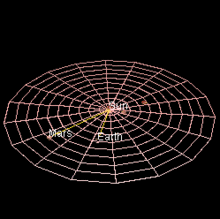
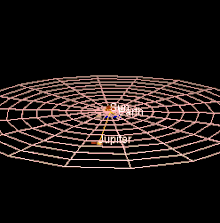


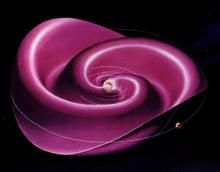


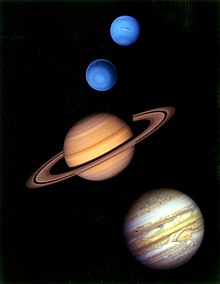

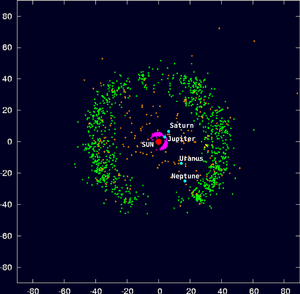









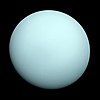
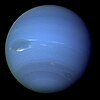




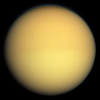


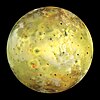

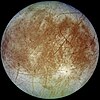
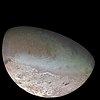



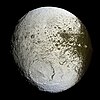





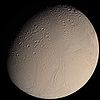

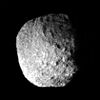
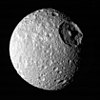











0 comments:
Post a Comment